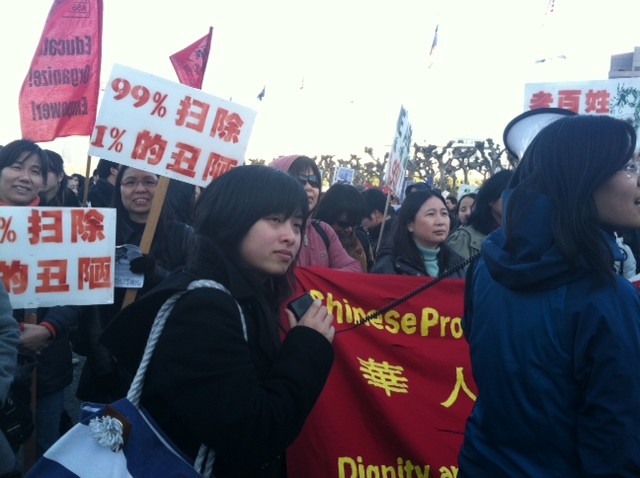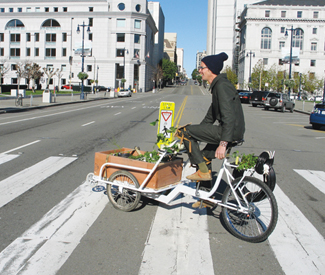Since club life is unpredictable, it’s a good idea to call ahead or check the venue’s website to confirm bookings and hours. Prices are listed when provided to us. Visit www.sfbg.com/venue-guide for venue information. Submit items for the listings at listings@sfbg.com. For further information on how to submit items for the listings, see Picks.
WEDNESDAY 7
ROCK/BLUES/HIP-HOP
Foreign Cinema, Tito Ramsey, Elle Nino Brick and Mortar Music Hall. 9pm, $7-$10.
Horde and the Harem, Archaeology, Bitter Honeys Elbo Room. 9pm, $7.
Hyde Street Band, Black Dreams El Rio. 9pm, $3.
Korallreven, Giraffage, Finally Boys Independent. 8pm, $15.
La Sera, Cold Showers, Swiftumz Rickshaw Stop. 8pm, $10-$12.
Mean Jeans, Guantanamo Baywatch, Primitive Hearts, Wrong Words Thee Parkside. 8pm, $7.
One Way Station Boom Boom Room. 8pm, $5.
JC Rockit vs. Rome Balestrieri Johnny Foley’s Dueling Pianos. 9:30pm.
Terry Savastano Johnny Foley’s. 9pm, free.
Seshen, Candace Roberts 50 Mason Social House, SF; www.50socialmasonhouse.com. 7pm, free.
Soja, Gentleman & the Evolution, Anuhea Fillmore. 8pm, $27.50.
Swahili, Blonde Stranger, Feelings Hemlock Tavern. 9pm, $6.
JAZZ/NEW MUSIC
Cat’s Corner with Nathan Dias Savanna Jazz. 9pm, $10.
Chris Amberger Trio and Jazz Jam Yoshi’s Lounge. 6:30pm, free.
Cosmo AlleyCats Le Colonial, 20 Cosmo Place, SF; www.lecolonialsf.com; 7-10pm.
Dink Dink Dink, Gaucho, Michael Abraham Amnesia. 7pm, free.
Greg Gotelli Quartet Medjool, 2522 Mission, SF; www.medjoolsf.com. 6-9pm, free.
“Lucie Arnaz: Latin Roots” Rrazz Room. 8pm, $45.
Orquesta La Moderna Tradicion Yoshi’s. 8pm, $8.
Ricardo Scales Top of the Mark, 999 California, SF; www.topofthemark.com. 6:30pm, $5.
FOLK/WORLD/COUNTRY
“Oom Pah POW” Verdi Club, 2424 Mariposa, SF; www.savekusf.org. 7pm, $10. Save KUSF benefit polka party with Deutscher Musikverein, and Big Lou.
DANCE CLUBS
Anti/Life: New Industrial Dance Cafe Du Nord. 9:30pm, $8.
Booty Call Q-Bar, 456 Castro, SF; www.bootycallwednesdays.com. 9pm. Juanita MORE! and Joshua J host this dance party.
Coo-Yah! Som., 2925 16th St, SF; (415) 558-8521. 10pm, free. DJs Daneekah and Green B spin reggae and dancehall with weekly guests.
KUSF-in-Exile DJ Night Monarch, 101 Sixth St, SF; www.savekusf.org. 5:30pm. With DJ Evyn Stevyn.
Mary Go Round Lookout, 3600 16th St, SF; www.lookoutsf.com. 10pm, $5. Drag with Suppositori Spelling, Mercedez Munro, and Ginger Snap.
Megatallica Fiddler’s Green, 1333 Columbus, SF; www.megatallica.com. 7pm, free. Heavy metal hangout.
Vespa Beat Bliss Bar, 4026 24th St, SF; www.blissbarsf.com. 9pm, free. MSK.fm spins raregrooves, electroswing, and boogie.
THURSDAY 8
ROCK/BLUES/HIP-HOP
Andrew Jackson Jihad, Laura Stevenson and the Cans, Roar Bottom of the Hill. 9pm, $12.
Bela Fleck & the Flecktones Regency Ballroom. 8pm, $32.50-$45.50.
“Harvey Mandel Birthday Bash” Biscuits and Blues. 8 and 10pm, $22. With Nick Gravenites and Barry Goldberg.
“International Women’s Day Concert” Yoshi’s. 8pm, $45. With Big Brother & the Holding Company, Pamela Parker, Nonstop Bhangra, and more.
Jeff vs. Rome Balestrieri Johnny Foley’s Dueling Pianos. 9:30pm.
John Lawton Trio Johnny Foley’s. 9pm, free.
Last Ambassadors, Acacia, Miles Country Red Devil Lounge. 9pm, $8.
Erica Sunshine Lee, Chi McClean, Windy Hill Cafe Du Nord. 8:30pm, $12-$15.
Liz O Show, Craig Browning 50 Mason Social House, SF; www.50masonsocialhouse.com. 7pm, free.
Lonesome Jugtown Pirates, Howdy! Brick and Mortar Music Hall. 9pm, $7-$10.
Punch Brothers, Aoife O’Donovan Fillmore. 8pm, $25.
Spider Heart Radius Cafe, 1123 Folsom, SF; www.radiussf.com. 9pm, free.
Tortured Genies, Curious Mystery, Grace Sings Sludge Hemlock Tavern. 9pm, $7.
Twilight Sad, Velvet Teen, Micah P. Hinson Independent. 8Pm, $15.
Twin Atlantic, Soft White Sixties, popscene DJs Rickshaw Stop. 9:30pm, $8-$10.
JAZZ/NEW MUSIC
Stompy Jones Top of the Mark, 999 California, SF; www.topofthemark.com. 7:30pm, $10.
Tom Lander & Friends Medjool, 2522 Mission, SF; www.medjoolsf.com. 6-9pm, free.
Last Ambassadors, Acacia, Miles County Red Devil Lounge. 9pm, $8.
Grant Levin Yoshi’s Lounge. 6:30pm, free.
“Lucie Arnaz: Latin Roots” Rrazz Room. 8pm, $45.
FOLK/WORLD/COUNTRY
Twang! Honky Tonk Fiddler’s Green, 1330 Columbus, SF; www.twanghonkytonk.com. 5pm. Live country music, dancing, and giveaways.
DANCE CLUBS
Afrolicious Elbo Room. 9pm, $5. With DJ/host Pleasuremaker and guest DJ Said spin Afrobeat, Tropicália, electro, samba, and funk.
Get Low Som., 2925 16th St, SF; (415) 558-8521. 10pm, free. Jerry Nice and Ant-1 spin Hip-Hop, 80’s and Soul with weekly guests.
Intel Presents: Sticky K, Daims & ChriSupreme, MPHD Public Works. 9pm, free before 10:30pm, $5 after.
Lions, Tigers, and Queers Underground SF. 10pm-2am, $3. Indie, Electro, and House dance party with resident DJ Becky Knox and special guests.
Thursdays at the Cat Club Cat Club. 9pm, $6 (free before 9:30pm). Two dance floors bumpin’ with the best of 80s mainstream and underground with DJ’s Damon, Steve Washington, Dangerous Dan, and guests.
Tropicana Madrone Art Bar. 9pm, free. Salsa, cumbia, reggaeton, and more with DJs Don Bustamante, Apocolypto, Sr. Saen, Santero, and Mr. E.
FRIDAY 9
ROCK/BLUES/HIP-HOP
Apparat (Full Live Band) 1015 Folsom. 10pm, $15-$20.
Barn Owl, Date Palms, Ensemble Economique Lab, 2948 16th St, SF; www.thelab.org. 8pm, $7-$15.
Big Light, Flowmotion is the True Spokes, Current Swell Brick and Mortar Music Hall. 9pm, $7-$10.
Body & Soul Johnny Foley’s. 9pm, free.
Counting Crows, Tender Mercies Slim’s. 9pm, $45.
Crazies Will Destroy You, Shotgun Break, Hi-Tones Hemlock Tavern. 9:30pm, $6.
Crocodiles, Bleeding Rainbow, Terry Malts Rickshaw Stop. 9pm, $12.
Dumpstaphunk, Papa Grows Funk Independent. 9pm, $25.
Fast Times, Wonder Bread 5 Red Devil Lounge. 8pm, $15.
Foreverland, Live Wire Bimbo’s. 9pm, $22.
Daryl Hance Connecticut Yankee, 100 Connecticut, SF; www.theyankee.com. 10pm, $5.
John Lee Hooker Jr. Biscuits and Blues. 8 and 10pm, $22.
Invaded By Unicorns Public Works. 9pm, $10. Charlie the Unicorn art car fundraiser with Pumpkin, Whitenoize, and more.
Daniel Krass, Rome Balestrieri, Greg Zema Johnny Foley’s Dueling Pianos. 9pm.
Jason Movrich & Friends Giordano Bros., 303 Columbus, SF; www.jasonmovrich.com. 9pm, free.
Points North, Full On Flyhead, Seth Chapla, Bad Boy Eddy Great American Music Hall. 9pm, $14-$18.
Railroad Earth, Greensky Bluegrass Fillmore. 9pm, $25.
Sioux City Kid, Tiny Television, Erin Brazill and the Brazillionaires Cafe Du Nord. 9:30pm, $10-$12.
Tumbleweed Wanderers, Guy Fox, Fox & Woman Bottom of the Hill. 9pm, $10.
JAZZ/NEW MUSIC
American Beauty Project Yoshi’s. 8pm, $32; 10pm, $28. With Ollabelle, David Mansfield, Jim Lauderdale, and Catherine Russell.
Audium 1616 Bush, SF; www.audium.org. 8:30pm, $20. Theater of sound-sculptured space.
Black Market Jazz Orchestra Top of the Mark, 999 California, SF; www.topofthemark.com. 9pm, $10.
Broken Strings Yoshi’s Lounge. 6pm, free.
“Lucie Arnaz: Latin Roots” Rrazz Room. 8pm, $45.
ToKiMONSTA, DiBiA$e, Knxwledge, Flying Skulls Yoshi’s Lounge. 10:30pm, $20.
FOLK/WORLD/COUNTRY
Taste Fridays DanceSF, 650 Indiana, SF; www.tastefridays.com. 7:30pm, $15. Salsa lesson, dancing, live Latin band.
DANCE CLUBS
Blow Up: Felix Da Housecat DNA Lounge. 10pm, $18.50-$20. Electro and house with Felix Da Housecat, resident DJ Jeffrey Paradise, and guests.
Bombshell Betty and her Burlesqueteers Elbo Room. 9pm, $15. With live music by Los Shimmy Shakers and Fromagique.
Donuts Public Works. 9pm. With Beautiful Swimmers, Sapphire Slows, Haceteria, and Magic Touch.
Indie Slash Amnesia. 10pm. With DJ Danny White.
Joe Lookout, 3600 16th St,SF; www.lookoutsf.com. 9pm. Eight rotating DJs, shirt-off drink specials.
Old School JAMZ El Rio. 9pm. Fruit Stand DJs spinning old school funk, hip-hop, and R&B.
Paris to Dakar Little Baobab, 3388 19th St, SF; (415) 643-3558. 10pm, $5. Afro and world music with rotating DJs including Stepwise, Steve, Claude, Santero, and Elembe.
Pledge: Fraternal Lookout. 9pm, $3-$13. Benefiting LGBT and nonprofit organizations. Bottomless kegger cups and paddling booth with DJ Christopher B and DJ Brian Maier.
SATURDAY 10
ROCK/BLUES/HIP-HOP
Baby and the Luvies Amnesia. 7pm, $5.
Rome Balestrieri, Greg Zema, Randy Johnny Foley’s Dueling Pianos. 9pm.
Roem Baur Apple Store, One Stockton, SF; (415) 392-0202. 3pm, free.
Blue Note Rendezvous, Todd Morgan & the Emblems 50 Mason Social House, SF; www.50socialmasonhouse.com. 7pm, free.
Counting Crows, Tender Mercies Great American Music Hall. 9pm, $45.
William Fitzsimmons, Denison Witmer Independent. 9pm, $20.
Grave Babies, Permanent Collection, Chasms Hemlock Tavern. 9:30pm, $7.
Hank IV, Electric Jellyfish, Mike Donovan, Carlton Melton El Rio. 9pm, $7.
Hot Lunch, Glitter Wizard, Lecherous Gaze, Knifey Spoony Thee Parkside. 9pm, $6.
Nneka Red Devil Lounge. 8pm, $20.
Rod Piazza & the Mighty Flyers Biscuits and Blues. 8 and 10pm, $22.
Quill Bender’s Bar. 10pm, $5.
Railroad Earth, New Monsoon Fillmore. 9pm, $25.
Red Elvises Cafe Du Nord. 9pm, $20
Seeking Empire, Trophy Fire, Water and Bodies Bottom of the Hill. 9:30pm, $10.
Slow Club, Signals, Y La Bamba Brick and Mortar Music Hall. 9pm, $9-$12.
Tall Shadows Johnny Foley’s. 9pm, free.
Underscore Orkestra Amnesia. 9pm, $5.
Voodoo Saints, Black Caucus Thee Parkside. 3pm, free.
Saul Williams, CX Kidtronik Slim’s. 9pm, $22.
JAZZ/NEW MUSIC
Audium 1616 Bush, SF; www.audium.org. 8:30pm, $20. Theater of sound-sculptured space.
“Bay Area Harmony Sweepstakes A Cappella Festival” Palace of Fine Arts, 3301 Lyon, SF; www.harmony-sweepstakes.com. 8pm, $24. With Continuum, Gimme 5!, House Blend, and more.
Charles Unger Experience Yoshi’s Lounge. 6:30pm, free.
Four Bags Red Poppy Arthouse. 8pm, $15.
Dave Hollister Yoshi’s. 8pm, $36; 10pm, $32.
“Lucie Arnaz: Latin Roots” Rrazz Room. 8pm, $45.
Lynne Arriale Trio Yoshi’s. 8pm, $20.
Marcus Shelby Trio Herbst Theatre, 401 Van Ness, SF; www.sfjazz.org. 11am, $5-$10. Family matinee.
Toots Thielemans, Kenny Werner & Oscar Castro-Neves Herbst Theatre, 401 Van Ness, SF; www.sfjazz.org. 8pm, $25-$65.
FOLK/WORLD/COUNTRY
Saturday Night Salsa Ramp, 855 Francois, SF; www.facebook.com/therampsf. 5:30pm, $10.
“Ukrainian Concert Honoring 198th Anniversary of Taras Shevchenko” Ukrainian Orthodox Church Hall, 345 Seventh St, SF; (415) 330-0905. 5pm, $5-$10.
DANCE CLUBS
Bootie SF: Good Vibrations DNA Lounge. 9pm, $10-$20. With resident DJ Robin Skouteris, Smash-Up Derby, and Bootie DJs Adrian and Dada.
Club Gossip Cat Club. 9pm, free before 9:30pm, $5-$8 after. With VJs Shon, Low Life, Damon, and more.
Cockblock Rickshaw Stop. 10pm, $5-$10. With Natalie Nuxx, DJ Andre.
Inferno Harlot, 46 Minna, SF; www.infernodances.com. 6-10pm, $10. Mustache party for women with DJ Rockaway.
Murk Terra Gallery, 511 Harrison, SF; Facebook: Arts&Beats with MURK. 3pm-4am, $20-$25. Arts&Beats art show with DJs Ralph Falcon, Oscar G, David Harness, and more.
Paris to Dakar Little Baobab, 3388 19th St, SF; (415) 643-3558. 10pm, $5. Afro and world music with rotating DJs including Stepwise, Steve, Claude, Santero, and Elembe.
Tormenta Tropical Elbo Room. 10pm, $5-$10. With resident DJs Shawn Reynaldo and Oro11, special guest DJ Lengua.
SUNDAY 11
ROCK/BLUES/HIP-HOP
Bottom, Backwoods Payback, Disastroid Hemlock Tavern. 9pm, $6.
Choir of Young Believers, Lime Colony Bottom of the Hill. 9pm, $12.
Malacates Trebol Shop Brick and Mortar Music Hall. 9pm, $15-$18.
Scarlett Fever DNA Lounge. 1-9pm, $15. Psychobilly, rockabilly, punk, and rock with Three Bad Jacks, Tombstone Brawlers, Cash Prophets, and more.
Violent Vickie, San Cha @ Musique Gang Bang Stud. 10pm. With DJs Tori, Knoxin.’
Underscore Orkestra Amnesia. 9pm, $5.
Yellow Monsters, Crying Nut, 3rd Line Butter Cafe Du Nord. 9pm, $12.
JAZZ/NEW MUSIC
Ken Berman, Kai Eckhardt Duo Bliss Bar, 4026 24th St, SF; www.blissbarsf.com. 4:30-730pm, $10.
Myrna DelRio Bliss Bar, 4026 24th St, SF; www.blissbarsf.com. 4:30-7:30pm, $10.
“Lucie Arnaz: Latin Roots” Rrazz Room. 7pm, $45.
Ricardo Scales Yoshi’s. 7pm, $22.
Ben Stolorow Yoshi’s Lounge. 6pm, free.
James “Blood” Ulmer Herbst Theatre, 401 Van Ness, SF; www.sfjazz.org. 7pm, $30-$50.
FOLK/WORLD/COUNTRY
Bernal Hill Players Community Music Center, 544 Capp, SF; www.sfcmc.org. 8pm, $10-$15.
Alex Jimenez, Lily Holbrook 50 Mason Social House, SF; www.50socialmasonhouse.com. 7pm, free.
Twang Sundays Thee Parkside. 4pm, free. With Porkchop Express.
DANCE CLUBS
Batcave Club 93, 93 9th St, SF 10pm, $5. Death rock, goth, and post-punk with Steeplerot, XChrisT, Necromos and c_death.
Dub Mission Elbo Room. 9pm, $6. Dub, dubstep, roots, and dancehall with DJ Sep, Vinnie Esparza, and Taal Mala.
Jock Lookout, 3600 16th St, SF; www.lookoutsf.com. 3pm, $2. Raise money for LGBT sports teams while enjoying DJs and drink specials.
La Pachanga Blue Macaw, 2565 Mission, SF; www.thebluemacawsf.com. 6pm, $10. Salsa dance party with live Afro-Cuban salsa bands.
MONDAY 12
ROCK/BLUES/HIP-HOP
Brian Bergeron Johnny Foley’s. 9pm, free.
Toshio Hirano Amnesia. 9pm.
Jackal Fleece, Junkdrawer Bottom of the Hill. 8:30pm, free.
Joy Formidable, A Place to Bury Strangers Independent. 8pm, $20.
Kirsten Opstad, Oceanography, Liz O Elbo Room. 9pm, $6.
Daryl Shawn, Ziva Hadar Bazaar Cafe, 5927 California, SF; (415) 831-5620. 7pm, free.
JAZZ/NEW MUSIC
Bossa Nova Tunnel Top, 601 Bush, SF; (415) 722-6620. 8-11:30pm, free. Live acoustic Bossa Nova.
Cava Menzies Quintet Yoshi’s Lounge. 6:30pm, free.
Linda Purl Rrazz Room. 8pm, $35.
FOLK/WORLD/COUNTRY
George Kahumoku Jr., Dennis Kamakahi, Uncle Richard Ho’opi’i Yoshi’s. 8pm, $24.
DANCE CLUBS
Death Guild DNA Lounge. 9:30pm, $3-5. Gothic, industrial, and synthpop with Joe Radio, Decay, and Melting Girl.
Krazy Mondays Beauty Bar, 2299 Mission, SF; www.thebeautybar.com. 10pm, free. Hip-hop and other stuff.
M.O.M. Madrone Art Bar. 6pm, free. DJs Timoteo Gigante, Gordo Cabeza, and Chris Phlek playing all Motown every Monday.
Sausage Party Rosamunde Sausage Grill, 2832 Mission, SF; (415) 970-9015. 6:30-9:30pm, free. DJ Dandy Dixon spins vintage rock, R&B, global beats, funk, and disco at this happy hour sausage-shack gig.
Vibes’N’Stuff El Amigo Bar, 3355 Mission, SF; (415) 852-0092. 10pm, free. Conscious jazz and hip-hop from 1960s-early ’90s with DJs Luce Lucy, Vinnie Esparza, and more.
TUESDAY 13
ROCK/BLUES/HIP-HOP
Jeff Bergey, High Beams 50 Mason Social House, SF; www.50socialmasonhouse.com. 7pm, free.
Zachary Blizzard, Survival Guide, San Francesca, Little Red Lung Brick and Mortar Music Hall. 9pm, $5-$8.
Bum City Saints, Dead Panic, Bite, Poor Luckies Bottom of the Hill. 8:30pm, $8.
Business End, Connies, M Section Elbo Room. 9pm, $6.
Grandma’s Boyfriend, Pink Films, Broonies Hemlock Tavern. 9pm, $6.
In Letter Form, Lights Become Stars, Thank You Rosekind, Antarctica El Rio. 7pm, $7.
Islands Hotel Utah. 7 and 10pm, $15.
Joy Formidable, A Place to Bury Strangers Independent. 8pm, $20.
Memoryhouse, Sister Crayon, James and Evader Rickshaw Stop. 8pm, $12.
Stan Erhart Band Johnny Foley’s. 9pm, free.
JAZZ/NEW MUSIC
David Correa and Cascada Yoshi’s Lounge. 6:30pm, free.
Charles Neville, Youssoupha Sidibe, Mystic Rhythms Yoshi’s. 8pm, $22.
DANCE CLUBS
Eclectic Company Skylark, 9pm, free. DJs Tones and Jaybee spin old school hip hop, bass, dub, glitch, and electro. Post-Dubstep Tuesdays Som., 2925 16th St, SF; (415) 558-8521.10pm, free. DJs Dnae Beats, Epcot, Footwerks spin UK Funky, Bass Music.








